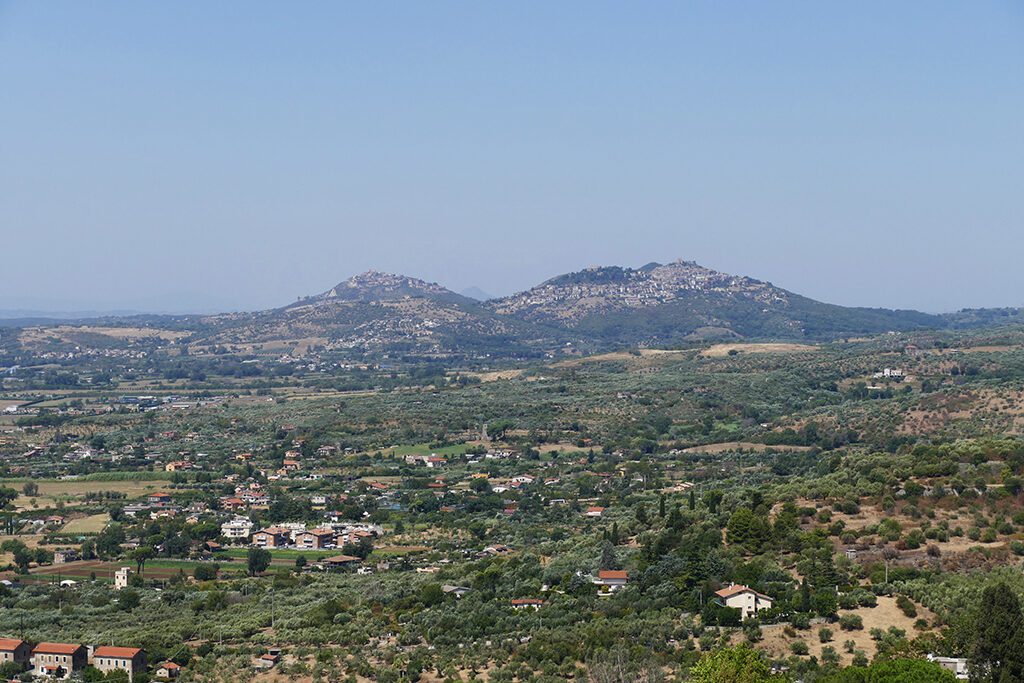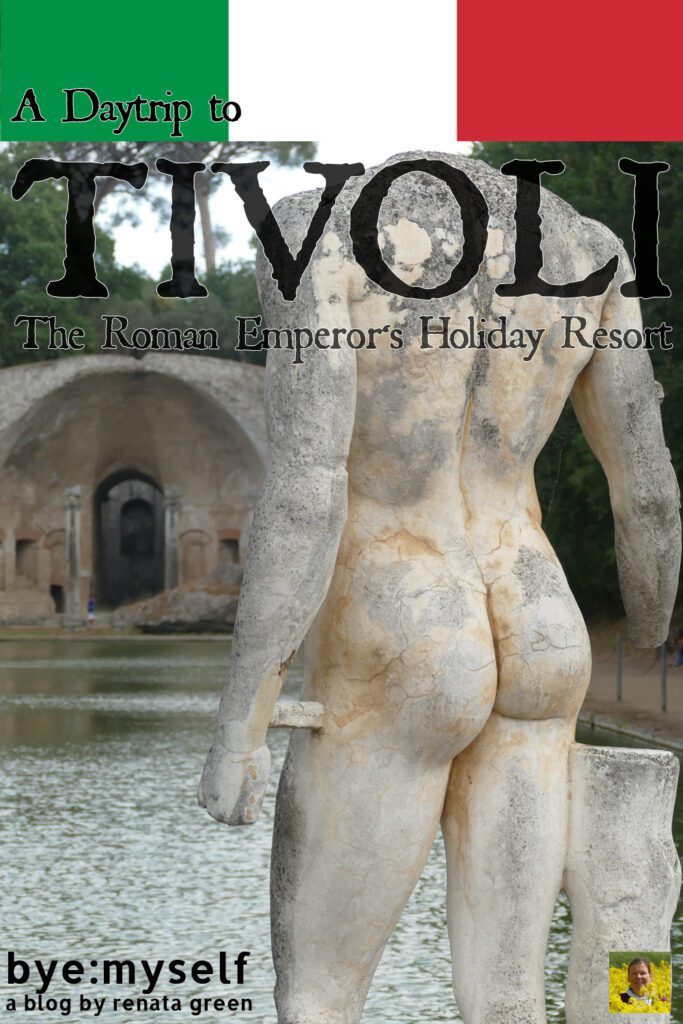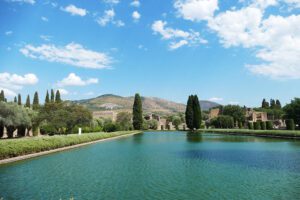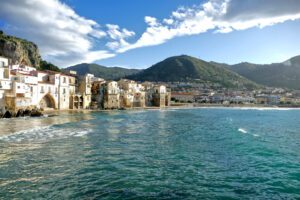A day trip from Rome took me to Tivoli where I found mesmerizing villas and playful waters. In short, the remnants of Antique Roman wealth.

Mind you, already Mr. Hadrian used to spend relaxing weekends at Tivoli almost 2,000 years ago.
So when I had to choose just one day trip from Rome, I finally decided against hitting the beach. With a little yearning for the sea, I bought a ticket and went in the opposite direction. Straight to the Roman Campagna.
The luxurious holiday resort of Emperors and Popes sounded too exceptional to resist.
Tivoli
Tivoli – but isn’t that this old-fashioned amusement park in Copenhagen?
Yes, indeed.
However, the true Tivoli lies around 30 kilometers east of Rome. It was this town that gave all those amusement parks their name.

It’s on the western slopes of the Tiburtina Mountains and the Aniene River. This idyllic location has attracted first emperors, then artists, and now tourists.
How it all Began
Roman Age
Tiber, Tibur, Tiberius – the Roman river, the Etruscan Tivoli, or the ancient Latin name – they are all honoring Tiburtus. According to Roman mythology, Amphiaraus’ grandson Tiburtus came to Italy to found Tibur, today’s Tivoli.
In 90 BC, the city became part of Rome. Its beauty and excellent waters made it a famed resort so that wealthy Romans commissioned beautiful villas in the area.

The most famous one, of which today only ruins remain, has been the Villa Adriana. On the city’s outskirts, Emperor Hadrian commissioned this extensive complex as his summer residence.
Eventually, in the 8th century AD, Charlemagne conquered Italy. Henceforth, Tivoli was under the authority of a Count, serving the Emperor.
From the Middle Ages to the Renaissance
In the Middle Ages, Tivoli was one of the most important places around Rome. Actually, it was Rome’s most ardent rival regarding the power over central Lazio.
From the 10th century onwards, Tivoli was an independent commune. It was governed by elected consuls.

During the Renaissance era, popes and cardinals did not limit their improving and embellishing activities to Rome. They also commissioned buildings in Tivoli.
In 1461, Pope Pius II built the massive Rocca Pia as a symbol of the permanence of papal power.

From the 16th century, the city experienced further construction of villas.
Tivoli Today
Yes, Tivoli is a cute little town. But if you’ve been to other places in Italy, it probably won’t overwhelm you.

The most alluring attractions are definitely the three villas. However, you’ll need an entire day if you plan on visiting all three of them.

If you have more time to spare, there is also the above-mentioned fortress Rocca Pia. Then, there are the Tivoli Cathedral, the Roman Temple of the Tosse, and the Temple of Hercules. All three landmarks are within walking distance from the Villa d’Este.

Apart from tourism, Tivoli’s main sources of income are the vineyard and olive groves on the neighboring hills. They add this specific Italian flair to the rolling hills and pleasing landscape.
Villa Gregoriana
Of the three sites that I’m introducing in this post, the Villa Gregoriana is actually the youngest complex. Howsoever, it’s the first villa you’ll reach when coming from Tivoli’s train station. Hence, I opted for order by geography rather than chronology.
The Villa Gregoriana is actually a large park. Here, you can enjoy the charming ensemble of ancient Roman elements and a romantic garden.

(Photo: trolvag, Tivoli, Metropolitan City of Rome, Italy – panoramio – trolvag (13), cropped 2:3, CC BY-SA 3.0)
Pope Gregory XVI. commissioned the greeneries of the Villa Gregoriana. After the devastating flood of 1826, he intended to protect Tivoli from the destructive floods of the Aniene. Hence, he built a waterfall as an outlet for the river’s waters. Today, this chute plunges 120 meters down into the villa.
As a matter of fact, he tried to combine the useful with the aesthetic.
Note
Maybe this is a fine moment to make clear that a villa in Italian doesn’t refer exclusively to a mansion. That would be rather a palazzo. Villa describes rather a manor or estate. Therefore, it might be confusing that the Villa Borghese in Rome is not some fat crib but a spacious park.
So don’t worry, the waterfall running into the villa will not cause any water damage.

To adorn the gardens of the Villa Gregoriana, ruins of the former villa of Manlius Vopiscus were placed there. Also, steps, paths, and passageways were added. The work was then completed in 1835.
Villa d’Este
Also, the glorious Villa d’Este can be easily reached by walking. Coming either from the train station or the Villa Gregoriana, you cross the Piazza Massimo. At the next corner, you turn from the Viale Roma right into the Vicolo dei Sosii. Up a narrow alley, you find yourself at Tivoli’s historic center.

The Villa d’Este is the most important landmark in the downtown area. Consequently, there are signs and you’ll easily find your way to the Piazza Trento.

Here, right next to the church Santa Maria Maggiore, is the entrance to the truly spectacular premises.
Commissioning a Masterpiece
From 1550, Cardinal Ippolito II d’Este was the governor of Tivoli. For having ecclesiastical as well as secular ties, he became one of the wealthiest cardinals of his time.

His residence at a former Benedictine monastery soon did not meet the Cardinal’s requirements anymore. On the other hand, it had a fantastic view of the landscape, greeneries, as well as extensive water reservoirs.

Therefore, Ippolito, instead of chartering a U-Haul-truck, planned a garden on the slopes of the Valle Gaudente below his palace. The artist and architect Pirro Ligorio sketched the blueprint. Court architect Alberto Galvani then implemented the designs.

The best artists of late Roman Mannerism such as Durante Alberti, Girolamo Muziano, Cesare Nebbia, Antonio Tempesta, and Federico Zuccari richly decorated the walls and ceilings of the palace.

After Ippolito
33 years after Ippolito’s death, his successor Cardinal Alessandro d’Este commissioned further work in 1605.
The existing systems were restored, but the overall conception of the gardens changed extensively. Also, the decorations of the fountains were renewed. Now, even Roman superstar Gian Lorenzo Bernini was involved
In the 18th century, the complex, then owned by the House of Habsburg, decayed from poor maintenance.
The gardens ran to seeds, the fountains ran dry, and the ancient statues collapsed.

This decline lasted until the middle of the 19th century. Then, Gustav-Adolf Prinz zu Hohenlohe-Schillingsfürst received the villa from the Dukes of Modena. The Prince initiated a series of restorations in 1851.

In 1869, Franz Liszt, who had visited the Prince a couple of times, moved to the Villa d’Este. Here he composed three piano pieces that he later included in the album Années de pélerinage.
At the end of WWI, the villa became the property of the Italian state. In the 1920s, after extensive renovation, it was finally opened to the public.
The Gardens
While the mansion’s walls and ceilings are superb, the part that will just blow you away is the gardens. They are an exquisite masterpiece of gardening art’n’architecture. From the villa’s terrace, they extend down a slope.
On 4.5 hectares are more than 500 fountains, water features, grottos, and basins as well as a water organ. The natural gradient could have been an obstacle. But if anything, it improved the artful designs of the enormous facility.
The garden consists of two parts with quite different characters. On the upper part, the famous Avenue of the Hundred Fountains connects the Fontana dell’Ovato with the Fontana della Rometta.

The Ovato forms the most important water reservoir on the premises. A branch of the Aniene river emerges through an underground waterway. Then, it is distributed to other canals feeding into the system. On top of an artificial mountain above the fountain is a Pegasus statue.

At the western end of the Fountain Avenue is the Fontana di Rometta. Sadly, a backdrop that depicted ancient Rome was largely demolished around 1855. This fountain represents Rome’s cultural heyday.


Going Down
As you continue down the stairs to the garden’s lower part, you pass more beautiful sculptures and fountains.

On the lower garden level, you’ll find three large fish ponds in a row. The last basin cuts into the north-eastern slope and is closed off by a double terrace. Here are the imposing Neptune Fountain and the amazing water organ. It used to be water-powered until the end of the 18th century.

Only recently, it has been repaired and can be heard again since 2003. The organ has 144 pipes controlled by a water-powered pin roller. It can play four Renaissance pieces lasting for four minutes in total. Beginning at 10.30 a. m., the organ plays every two hours.

On the opposite side, Ligorio built an exedra that protrudes from the garden’s boundary. From here you have a truly overwhelming panoramic view of the valley.

One of the most impressive fountains is the Fontana di Diana Efesia. It is a copy of the famous statue of Diana of Ephesus. Flemish sculptor Gillis Van den Vliete made it in the late 16th century.

Diana of Ephesus is the lady of the woods and wildlife, guardian of springs and streams, protector of women, and, therefore, invoked by women at childbirth.

Hadrian’s Villa
As I looked up on google maps how to get to Hadrian’s Villa walking, it seemed absolutely doable. About five kilometers that I could easily walk in one hour.
However, once I was there, it got really hot. Also, I had already visited the other sites. Hence, I was not that keen on hiking along a road with kids waving at me from the backseat of their parents’ cars. So with the help of my cellphone and a friendly young Italian, I checked for a convenient bus connection. The coach dropped me off right at the Villa’s main entrance. And you should do that, too.
The Emperor’s Retirement Home
The Hadrian’s Villa was built from 118 to 134 AD. It was the Emperor’s summer residence and retirement home.

It consists of 125 hectares of built-up area and green spaces. They are making it the largest and most elaborate palace complex that a Roman emperor had ever commissioned. The gigantic complex was also a form of imperial power staging, obviously.
Hadrian’s villa was part of the country estates of the Roman aristocracy. Roman nobles often commissioned mansions on the cities’ outskirts. It made them suitable for varied leisure activities.

Supposedly, amidst the large area later used by Hadrian, there had already been a villa during the Republican era. It is assumed that the Gens Vibia, the family of Hadrian’s wife Sabina, owned that predecessor villa. Later, it was replaced by Hadrian’s extensive estate.
After Hadrian
After Hadrian’s death, the villa passed into the possession of the subsequent emperors, but was much less used. Eventually, in the 3rd century with the founding of Constantinople, bad decay and looting began. Statues, high-quality marble, and other parts were removed.

Despite all the removals and robberies, about 300 works of art were found in the Villa Adriana. Today, they are mostly presented in various museums, for example in the Vatican Museums in Rome.
Particularly precious are the mosaics found in the triclinium of the Small Palace in 1779. The world-famous Centaur mosaic has been in the Altes Museum in Berlin since 1848.
Picking Up the Pieces
In the 15th century, the Villa Adriana gained importance as an extraordinary ancient ensemble of remnants. It gained new fame and was a fine model for many baroque gardens.

Rather an estate than a mansion, it is the best-preserved complex of this type from Roman times.

But the multifaceted architecture of the Villa Adriana reflected also the impressions from Hadrian’s travels. He had extensively ventured to the provinces of the Roman Empire, especially to Greece and Egypt.
By the Waters
Author and natural philosopher Pliny the Elder wrote about Tivoli’s waters in his encyclopedia Naturalis Historia. “The greatest of all aqueducts in the whole world, the highest in freshness and cleanliness for the glory of the city is that Aqua Marcia. Among all the gifts that the gods have given the city. ”

The water requirements of Hadrian’s villa were met by an underground hydraulic system. There weren’t only thermal baths, but also basins, ponds, and ornamental fountains. A separate supply aqueduct provided the villa with water.
To this date, the basins such as the Poecile, the Canopus, and the Teatro Maritimo are the villa’s most picturesque features.
Practical Information
How to Get to Tivoli on a Day Trip
For a day trip, Tivoli is the perfect location. Only 30 kilometers east of Rome, it can be reached in about one hour.
Obviously, you can drive there. However, taking the train will possibly be less stressful. Most trains are leaving from the station Roma Tiburtina, however, there are also connections from Roma Termini. You can check convenient connections on google maps as well as on the website of trenitalia, the national train company. It’s very clear and well-functioning. Also, you can buy your ticket online*.
Once you get to Tivoli, you can reach the Villa Gregoriana and Villa d’Este walking. To get to the Villa Adriana, however, you should take the bus. Even though it’s only six kilometers from the town center, it’s simply not a nice route.
My Tip
The buses from Tivoli to the Villa Adriana are not going very often. Hence, I recommend that you first check the schedule at the bus station on Piazza Massimo. Then you can plan your visit accordingly. If the bus is coming soon, you wait for it. If not, you first visit the other two villas and take a later bus.
The local C.A.T. bus offers many connections departing from the center of Tivoli to the Villa Adriana. You can check the schedules on this website. Look for bus #4 towards Campolimpido.
Note that you cannot buy your ticket from the driver! You have to obtain it for instance at a bar or a newspaper stand. Then, you have to devaluate it at the machine on the bus.
On the way back, you can purchase bus tickets at Villa Adriana’s ticket booth.
Planning Your Visit
To visit the villas, you need tickets, obviously.
The general admission to the Villa Gregoriana are 6 €uros. The other two villas cost you 12 €uros each. Unfortunately, there is no collective ticket.
Villa Gregoriana
During high season from April to October, the villa is open from Tuesday to Sunday from 10 a.m. to 6.30 p.m.
In March, November, and December, opening times are between 10 a.m. and 3 p.m.
In January and February as well as Mondays, the Villa Gregoriana is closed to the public.
Villa d’Este
The villa opens at 8.30 a. m. from Tuesday to Sunday.
The closing times differ from 4.45 p. m. during the Winter months to 7.30 p. m. from May to August.
Therefore, please check their website before you go.
That’s something you should always do, anyway.
Hadrian’s Villa
The villa opens at 8.30 a.m. The closing times differ from 5 p.m. in January to 7.30 p.m. during the summer months.
Therefore, please check their website before you go.
That’s something you should always do, anyway.
Getting There Organized
Especially if you don’t have much time or don’t feel like planning your trip yourself, joining an organized tour will be a great alternative. Although I’m a devoted solo traveller, on day trips, I do enjoy the company of strangers*:
Where to Stay
Of course, you can also spend the night in Tivoli. Here are some ideas of where to stay*:
Where to Eat
Where to Eat? Tivoli is catering to tourists, hence there are many restaurants in town. In general, they are a bit cheaper than in Rome.

So you certainly won’t be starving and you don’t need to burn a hole in your wallet.
There is a good choice of small restaurants around the square Largo Cesare Battisti. A particular scenic place to enjoy lunch or dinner is around the Piazza Trento. This is also the square from where you enter the Villa d’Este.
Cash And Cards
Until now, 20 European countries replaced their former local currency with the €uro starting in 2002. Obviously, Italy is one of them. The exchange rate is 1 US$ = 0.84 EUR as of August 2025. However, you can check today’s conversion rate on this page.
At Tivoli, you can pay by credit card at all major businesses and also at the three villas. There are also banks and ATMs.
Language
Although Tivoli is quite touristy, people don’t necessarily speak English fluently. At least not voluntary. So while they halfheartedly make an effort to understand what you’d like, they’ll probably snort and roll their eyes. Don’t take it personally.
Anyway, you might want to learn some basic Italian vocabulary on babbel.
Map
This map will make finding the sites that I’m introducing in this post easy for you.
Clicking on the slider symbol at the top left or the full-screen icon at the top right will display the whole map including the legend.
Pinnable Pictures
If you choose to pin this post for later, please use one of these pictures:






Note: This post is being regularly completed, edited, and updated – last in August 2025.
Did You Enjoy This Post? Then You Might Like Also These:
What Not to Miss in TAORMINA, the Most Beautiful Town in Sicily
The Valley of the Temples of Agrigento And La Villa Romana del Casale di Piazza Armerina: A Day Trip Not to Miss
Best Street Art in PALERMO
Comprehensive Guide to ROME – For First-Timers, Repeat Visitors, And Eternal Admirers
One Day in CATANIA, Sicily’s Building Ground of Grand Palaces
Sea, Salt, and Sunset: Experiencing the Best of TRAPANI
TIVOLI – Villas, Waters, and Wealth. A Day Trip from Rome
From Clifftop Views to Gelato Scoops: A Guide to CEFALÙ
* This is an affiliate link. If you book through this page, not only do you get the best deal. I also get a small commission that helps me run this blog. Thank you so much for supporting me!







